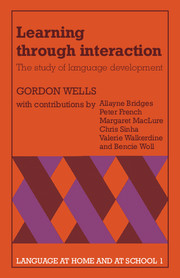Book contents
- Frontmatter
- Contents
- Acknowledgments
- Introduction
- 1 Language as interaction
- 2 Becoming a communicator
- 3 The development of comprehension
- 4 Context, meaning and strategy in parent–child conversation
- 5 Developing linguistic strategies in young school children
- 6 A comparison of talk at home and at school
- 7 Language, literacy and education
- Appendix Bristol language development study: transcripts
- References
- Index
Appendix - Bristol language development study: transcripts
Published online by Cambridge University Press: 05 June 2012
- Frontmatter
- Contents
- Acknowledgments
- Introduction
- 1 Language as interaction
- 2 Becoming a communicator
- 3 The development of comprehension
- 4 Context, meaning and strategy in parent–child conversation
- 5 Developing linguistic strategies in young school children
- 6 A comparison of talk at home and at school
- 7 Language, literacy and education
- Appendix Bristol language development study: transcripts
- References
- Index
Summary
Conventions and layout of transcripts
The speech of the child being studied is set out in the left-hand column. The speech of all other participants is set out in the centre column, with identifying initials were necessary. Each new utterance starts on a new line.
Contextual information is enclosed in square brackets [] and set out in the right-hand column.
Interpretations of utterances and descriptions of tone of voice, where applicable, are enclosed in round brackets () and included immediately after the utterance to which they apply.
Utterances, or parts of utterances, about which there is doubt are enclosed in angular brackets 〈 〉 where two interpretations are possible they are both given, separated by an oblique stroke.
Symbols of the International Phonetic Alphabet are used for utterances, or parts of utterances, which cannot be interpreted with certainty. Phonetic symbols are always enclosed by square brackets. Except where there is doubt about the speaker's intended meaning, the speech is transcribed in Standard English orthography.
The following is a list of additional symbols used, with an explanation of their significance (stops and commas are not used as in normal punctuation).
? used at end of any utterance where an interrogative meaning is considered to have been intended
! used at the end of an utterance considered to have exclamatory intention
' apostrophe: used as normal for contractions and elision of syllables
* used to indicate unintelligibility, for whatever reason.
Information
- Type
- Chapter
- Information
- Learning through InteractionThe Study of Language Development, pp. 277 - 282Publisher: Cambridge University PressPrint publication year: 1981
